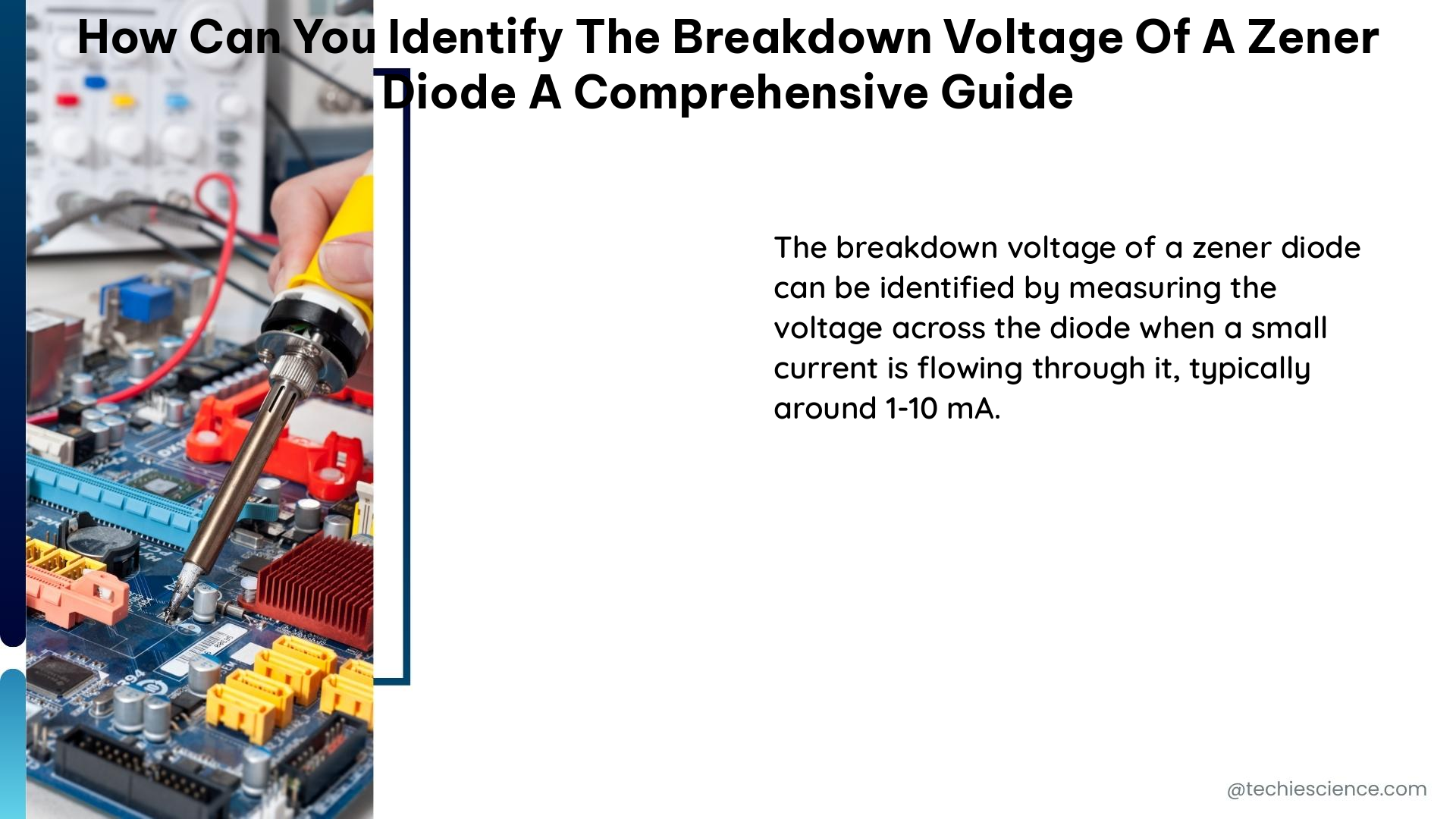Identifying the breakdown voltage of a Zener diode is a crucial step in understanding its behavior and ensuring its proper operation within an electronic circuit. This comprehensive guide will walk you through the process of accurately measuring the breakdown voltage of a Zener diode using a simple circuit that applies a constant current and measures the voltage across the diode.
Understanding Zener Diode Breakdown Voltage
The breakdown voltage of a Zener diode is the voltage at which the diode transitions from a high-impedance state to a low-impedance state, allowing current to flow in the reverse direction. This voltage is a critical parameter that determines the diode’s suitability for various applications, such as voltage regulation, voltage reference, and overvoltage protection.
Zener diodes are designed to operate in the breakdown region, where the voltage across the diode remains relatively constant despite changes in the current. The breakdown voltage of a Zener diode is typically specified by the manufacturer and can range from a few volts to several hundred volts, depending on the diode’s design and intended use.
Measuring Zener Diode Breakdown Voltage Using a Constant Current Source

To accurately measure the breakdown voltage of a Zener diode, you can use a circuit that applies a constant current to the diode and measures the voltage across it. This method is more accurate than using a resistive divider, as it eliminates the variability introduced by different resistance values and currents.
The circuit consists of the following components:
- Operational Amplifier (OpAmp): The OpAmp is configured as a non-inverting amplifier and is used to maintain a constant current through the Zener diode, regardless of changes in the power supply voltage.
- Constant Current Source: The constant current source provides a stable current to the Zener diode under test.
- Zener Diode Under Test: This is the Zener diode whose breakdown voltage you want to identify.
- Potentiometer (R2): The potentiometer is used to adjust the current through the Zener diode.
- Resistors (R3 and R4): These resistors are used to set the gain of the non-inverting amplifier and calculate the Zener voltage.
The circuit diagram for this setup is as follows:
+Vcc
|
|
R1
|
|
-----
| OpAmp |
-----
|
|
R2
|
|
-----
| Zener |
-----
|
|
R3
|
|
R4
|
|
GND
The output voltage of the non-inverting amplifier is given by the equation:
V0 = Vz * (R3 + R4) / R4
where Vz is the breakdown voltage of the Zener diode under test.
To measure the breakdown voltage:
- Adjust the potentiometer
R2to vary the current through the Zener diode. - Measure the voltage across the Zener diode using a multimeter or an oscilloscope.
- Calculate the Zener voltage
Vzusing the equation:
Vz = V0 * (R4 / (R3 + R4))
This method provides a more accurate measurement of the breakdown voltage than using a resistive divider and allows for the identification of any faults in the Zener diode.
Considerations and Best Practices
When measuring the breakdown voltage of a Zener diode using this circuit, there are a few important considerations and best practices to keep in mind:
- Power Supply: Use a single power supply for the OpAmp and connect the negative or
V-voltage to ground (GND) to avoid latch-up issues when powering up the circuit. - Zener Diode Ratings: Ensure that the maximum current and power dissipation rating of the Zener diode under test are not exceeded, as this can lead to thermal runaway and damage the diode.
- Resistor Values: Choose the values of
R3andR4carefully to ensure that the output voltageV0is within the operating range of the OpAmp and the measurement equipment. - Measurement Accuracy: Use a high-precision multimeter or oscilloscope to measure the voltage across the Zener diode, as small variations in the voltage can significantly impact the calculated breakdown voltage.
- Temperature Effects: The breakdown voltage of a Zener diode can be affected by temperature. If you need to measure the breakdown voltage at a specific temperature, you may need to use a temperature-controlled environment or consider the temperature coefficient of the diode.
- Zener Diode Selection: Choose a Zener diode with a breakdown voltage that is suitable for your application. Factors such as the required voltage regulation, power dissipation, and operating current should be considered when selecting the appropriate Zener diode.
Conclusion
Accurately identifying the breakdown voltage of a Zener diode is essential for understanding its behavior and ensuring its proper operation within an electronic circuit. By using a constant current source and an OpAmp-based circuit, you can obtain a more accurate measurement of the breakdown voltage compared to using a resistive divider. Remember to consider the power supply, Zener diode ratings, and measurement accuracy to ensure reliable and consistent results.
References:
- Build a Zener Diode Identifier
- Zener Diode: A Comprehensive Guide to Its Principles and Applications
- Zener Diodes: Understanding the Basics

The lambdageeks.com Core SME Team is a group of experienced subject matter experts from diverse scientific and technical fields including Physics, Chemistry, Technology,Electronics & Electrical Engineering, Automotive, Mechanical Engineering. Our team collaborates to create high-quality, well-researched articles on a wide range of science and technology topics for the lambdageeks.com website.
All Our Senior SME are having more than 7 Years of experience in the respective fields . They are either Working Industry Professionals or assocaited With different Universities. Refer Our Authors Page to get to know About our Core SMEs.